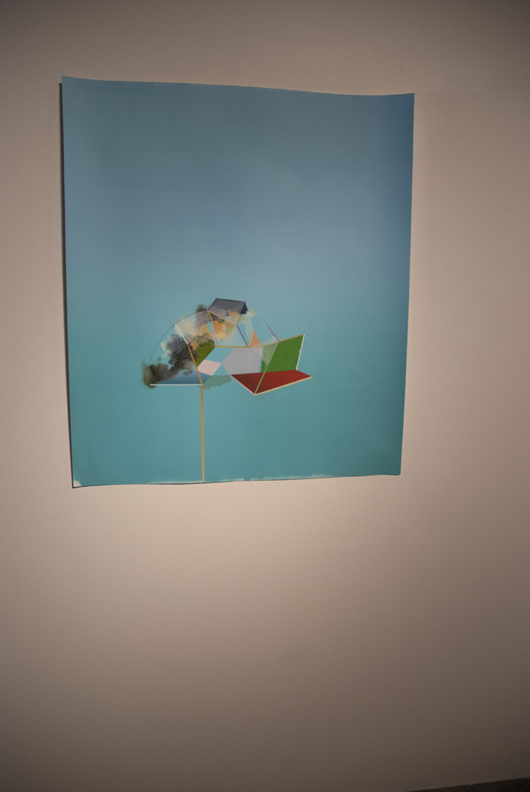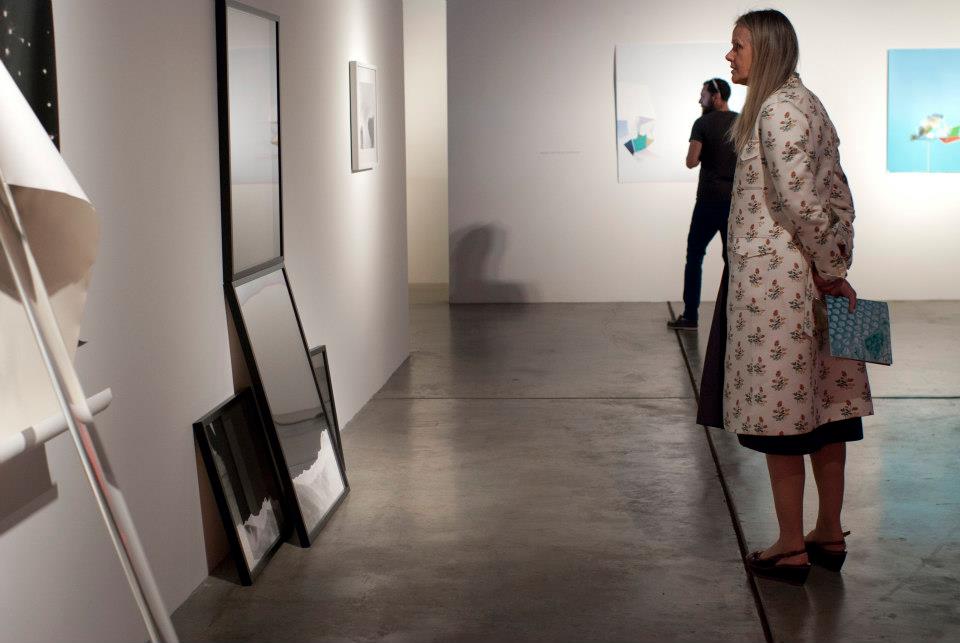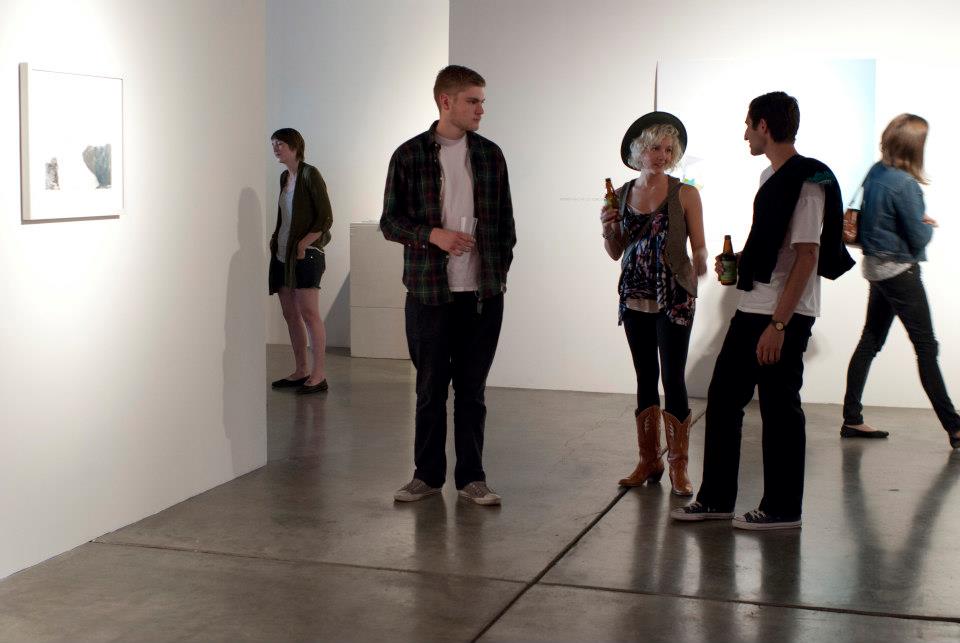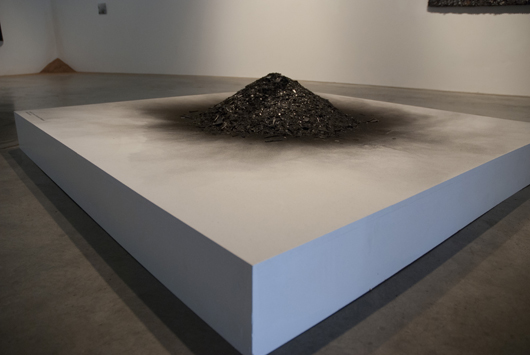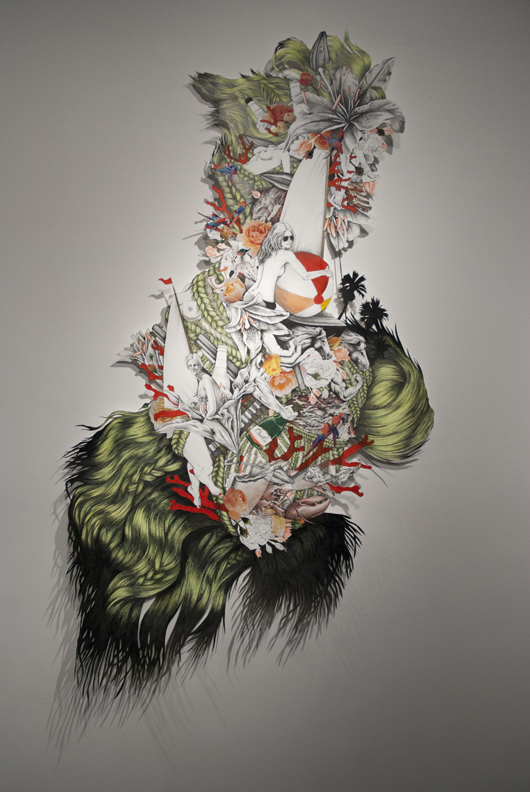Ruffled to Abstraction
A short essay on the work by Sara Huston and Jennifer Wall in Ruf•fle
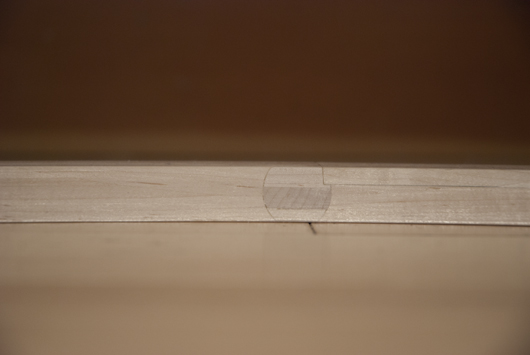
Ruf•fle
Open at the White Box July 13-August 24, 2013
Open from July 13 to August 24, 2013 at the University of Oregon in Portland School of Architecture and Allied Arts White Box Visual Laboratory, Ruf•fle presents plenty of opportunity for White Box visitors to engage in an examination of perception, identity, and the meaning of objects, complete with psychological and cultural aspects. The exhibition features work from a group of Portland-based women traversing opportunities uniquely afforded to interdisciplinary art and design dialogue. The work in Ruf•fle explores individual inquiry within an overarching collective and shared conversation. It is at once thought-provoking, unfamiliar and recognizable.
The inclusion of work in this exhibition by individuals Sara Huston and Jennifer Wall brings to the forefront the dynamic proximity of conversation and the representation of what it can mean to “ruffle.” Huston and Wall, both UO adjunct instructors in the Portland Product Design Program presented pieces that authentically represent the “diversity and value of collaborative analysis through cross-disciplinary insight” in exhibited pieces, Tiny Parametric Ruffles by Wall and Permanently Liminal by Huston.
Wall’s pieces, painstakenly and metaphorically hung as if 2-dimensional with miniscule brass pins driven into predrilled holes in the four corners of fine book paper, present objects that “chase down the ruffled relationship between parametric modeling software and adornment.” (Wall, White Box Ruf•fle catalogue). Indeed, Wall proclaims herself to be “both metalsmith and designer, both maker and designer” which is a dichotomy that informs her work translating with material eloquence into her designs. One might say, Wall’s work blends the rich and diverse worlds of modernity and antiquity simultaneously transitioning and questioning methods and process both ancient and contemporary. Her works soar from the mere designation of “jewelry” although on first glance what one sees is exactly that: objects in shapes traditionally and culturally recognized as rings, necklaces, small keepsakes, perhaps. But that is the peripheral, shallow view—look closer and see the materials ranging from the brilliant metallic allure of gold and silver, to white ABS plastic, to bronze, to aluminide and the natural, soft, shale-like layers of cuttlefish bone: all materials utilized to explore and push the idea of functionality of the design.

Wall begins her pieces within the technology of a CAD file using Grasshopper, she then moves to the 3-D printer (quite often using the equipment available in the UO PDX FabLab) creating her pieces in metals and plastics. She also works with the ancient technique of cuttlefish casting advocating for the “relationship between the cuttlefish bone texture and the 3-D print.” Wall sees in this collaboration an ambiguity hovering between the two—a pairing of “how things are made and how things appear.” Upon close inspection, the layers of each technique are visible, drawing an almost daring comparison between the two methods. This contrast between process and production as well as the final product, provides the tangible and visual representation of “ruffle”, says Wall, the “use of the 3-D printer and the use of the cuttlefish casting: it’s modernity and antiquity; the ruffles are in the layers; even the cuttlefish, as a living thing, ruffles its fins to propel itself through water.”

This play between the textures and the surfaces of the work, encouraged Wall to explore scale and the relationship between culturally-anticipated sized pieces, and pieces diminished or expanded beyond traditionally accepted norms. She also found a means to traverse the concept of adornment and how it functions as a symbol being both mediator and communication device between the wearer and the viewer.

Wall’s work has been grounded in this method of exploration for some time. She comments that she sees this body of work “….not as a departure but as pieces energized by the quality and diversity of 3-D printing. These are pieces that gain identity from materials—the color and reflectivity bringing a definition to the form.” Wall envisions her future work as propelled forward from her venture into scale with the pieces exhibited in Ruf•fle . She sees the potential for future work to embrace larger scale and to investigate kinetics and the adornment of space and buildings, as well as humans. Ruf•fle has also prompted her to observe her inherent fascination with two dimensional representation and the possibility of pieces made purely for the sake of display. As Wall says, “the role of the arts is to shape culture, and as a jeweler I can shape culture….I can work with personal identity and shifting of scale.” She continues, “I have a great interest in how culture can shift off the body, how adornment can be shifted from the body to the built environment, and onto buildings.”

Jennifer Wall’s work represents an elegant dance between two worlds, one of cutting-edge technology and one of ancient techniques. Her blending of these elements enhanced by a quintessential relationship to the materiality of each piece, places her work into a dialectic process of method and understanding. Discernable within her work are the mindful topics of change and interaction between form, shape, size, substance, and cultural meaning. It is through a process of abstraction that meaning is attributed to her work, or the process by which we think about how her work changes and interacts with us and our expectations.
Burrowing deep into the questions of change, interaction, and how all things relate to or define other things (including her work and her own self image and identity), merges Sara Huston, whose work also graces the White Box Ruf•fle space. Part of a self-professed “collaborative, interdisciplinary, avant-garde studio called ‘the last attempt at greatness,” Huston saw her integration into the Ruf•fle exhibition, (an exhibition she was instrumental in securing and curating for the group), as an opportunity to investigate her own feelings of struggle. Huston talks of a dichotomy between the interdisciplinary discussion: the idealistic yet not fully embraced concept of interdisciplinary work. She asserts “there has never been a separation between art and design, in my own work. . . .and this exhibition was a chance “to look into talking about this discussion, exploring it and how to validate it to [her]self and others.” Huston explains her work is “about [her] identity and how [she] identifies as a creative individual” resisting the public penchant to label her as either a designer or an artist—labels she feels she does not neatly fit into. Ruf•fle gave her a chance “to examine the space inbetween artist and designer and to push [her]self with a new medium.”

Having been involved in furniture (from the very literal and naïve definition) “making” projects, Huston’s work, Permanently Liminal was sparked by a sense of frustration from being called a “furniture maker” and the thought that she desired to reach far beyond the limitations of standard creative labeling or as she puts it, “I needed to exorcise or remove the theme of ‘furniture designer’ so as not to be pegged as one or the other.” Indeed, from her work (some viewable on her website), pieces such as Expectation 01 come across as what most would define as “furniture.” But the failure of her audience to look above and beyond the design aspect and not recognize the artistic component, was driving Huston to want to “rediscover how art and design and the space in between are like a religion and a mantra to [her].” Huston says, with a shy smile, “I am a provocateur.” A sense of wanting to question who she is and what she does, prompted her to create Permanently Liminal, a work that makes strong use of audio to get Huston’s point across.

Permanently Liminal demands a closer inspection. The circular threshold, at once familiar and yet oddly inappropriate, confronts the viewer with conflicting invitations: can one step over this threshold? And, to do so, where are you except in a confined and very limited space? Have you traversed some boundary or simply caged yourself within the halo of Huston’s finely sculpted sphere? This element of the circular liminality echoes back to a state of being on the precipice, existing in-between two or more acknowledged, perhaps, unclear, difficult, complex, and real situations. The threshold creates an environment for the individual to experience uncertainty, to be ruffled, to question what happens next, to be temporarily uncomfortable.

In one sense, Huston compels us to think about reality and what we need to do to break it down into comprehendable parts. She puts us in a static ring, unnervingly similar in color and material to the White Box floor, and subjects us to an audio and physical redundancy of her voice telling us what she is and is not; the circumference facing us with the same position from all positions. Huston boldly questions her surroundings by separating out specific features and focusing on and categorizing them in ways she wants her audience to pay attention to.
This confrontational method of abstraction, (“abstract” is from the Latin “abstrahere” meaning “to pull from”) diligently gives us a slice of her, at this stage, somewhat sullen art and creative angst. Huston comments that Permanently Liminal “completely disrupted [her]” and “confirmed [her] senses of who [she] [is].” The creation of this work forced her to examine how she “relates to the professional fields, the idea of interdisciplinary work, and what ways [she] can work with both industry and marketing to create a space for [herself] that is new.”
Maybe yet undefined, Huston’s own arcadian space without the classifications of artist, designer, or furniture-maker but confined only by the blonde circlet defining the grounded component of her installation, compels her to seek clarity by confrontation. Constructed into this installation are the elements of audio, visual, textural as the senses are called upon to test the limits of understanding and tolerance. Permanently Liminal is a collaboration of disciplines, a mélange of experiences. The multidisciplinary approach Huston show us has led her to a “whole new sense of [her]self, blown away the boundaries of media and audio and made [her] comfortable enough to want to manipulate and work within the digital realm.” Installing Permanently Liminal and reacting to it in the White Box space, Huston asserts that she now considers audio to be “a material” and she hopes to explore the medium as a tangible, physical experience “integrating it into the human psyche and conscious as well as subconscious.”
Both Huston and Wall expressed the sentiment that from experiencing their work and the work in the Ruf•fle exhibition, they anticipate their audiences being ruffled enough to gain new ways of looking at the world, at themselves, and at the boundaries, or lack thereof, in artistic and design disciplines. Presenting work like this in an environment receptive to change and experimentation creates opportunities for discovery of the arts and design as socially and environmentally anchored. And, as Huston reminds us, we must never forget the crucial human component and its importance to art and design, and life, influencing our reactions and how we interact and react to work. While we might abstract to attain meaning and relevance from this exhibit, the utmost value of challenging norms and experiencing situations that compel thought and contemplation, is to remember the Socratic philosophical mantra and remind ourselves, “the unexamined life is not worth living.” It is with exhibitions like Ruf*fle that we are provided the moments, spaces, objects and time to question, to pursue answers, to think to the best of our ability, to examine our lives.
Ruf•fle also includes work by:
Albertha Bradley
Ali Gradisher
Diane Pfeiffer
Flo & Goose
JJ Wright
Kari Merkl
Kate MacKinnon
Lydia Cambron
Natalie Barela
Noelle Bullock








